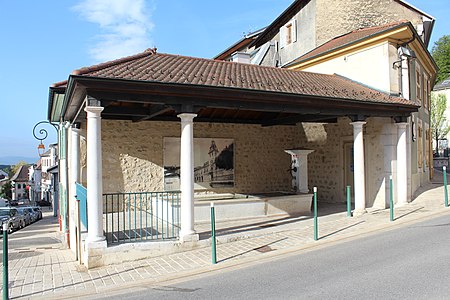Gex, Ain
You can help expand this article with text translated from the corresponding article in French. (December 2008) Click [show] for important translation instructions.
|
Gex | |
|---|---|
Subprefecture and commune | |
 Town hall | |
| Coordinates: 46°20′00″N 6°03′28″E / 46.3333°N 6.0578°E | |
| Country | France |
| Region | Auvergne-Rhône-Alpes |
| Department | Ain |
| Arrondissement | Gex |
| Canton | Gex |
| Government | |
| • Mayor (2014-2020) | Patrice Dunand |
| Area 1 | 32.02 km2 (12.36 sq mi) |
| Population (2021)[1] | 13,078 |
| • Density | 410/km2 (1,100/sq mi) |
| Time zone | UTC+01:00 (CET) |
| • Summer (DST) | UTC+02:00 (CEST) |
| INSEE/Postal code | 01173 /01170 |
| Elevation | 532–1,614 m (1,745–5,295 ft) (avg. 617 m or 2,024 ft) |
| 1 French Land Register data, which excludes lakes, ponds, glaciers > 1 km2 (0.386 sq mi or 247 acres) and river estuaries. | |
Gex (French: [ʒɛks]) (Italian:Gesio) is a commune in the Ain department in eastern France.
It lies 5 km (3.1 mi) from the Swiss border and 16 km (9.9 mi) from Geneva. It is a subprefecture of Ain.
History
The town gave its name to the Pays de Gex, at various times under the jurisdiction of France, Switzerland and the Duchy of Savoy.
With the 1815 Protocol of the Conference of Paris, (signed on 20 November) and the Treaty of Paris of the same date, Gex was placed in the Customs region of Switzerland and neutralised. The resolutions regarding the Pays de Gex were annulled by Art 435 of the Treaty of Versailles. In November 1923 France moved its customs office to Gex, and the matter was brought before the Permanent Court of International Justice (predecessor of the International Court of Justice), which decided in favour of Switzerland;[2] this case is also notable for being an early example of the doctrine of fundamentally changed circumstances being invoked before an international court.[3] A compromise was reached in 1932.
Historically, citizens spoke a dialect of the Franco-Provençal language but this dialect is not in use anymore.
Population
| Year | Pop. | ±% |
|---|---|---|
| 1793 | 2,398 | — |
| 1800 | 2,415 | +0.7% |
| 1806 | 2,354 | −2.5% |
| 1821 | 2,536 | +7.7% |
| 1831 | 2,834 | +11.8% |
| 1836 | 2,894 | +2.1% |
| 1841 | 2,835 | −2.0% |
| 1846 | 2,785 | −1.8% |
| 1851 | 2,874 | +3.2% |
| 1856 | 2,662 | −7.4% |
| 1861 | 2,602 | −2.3% |
| 1866 | 2,642 | +1.5% |
| 1872 | 2,675 | +1.2% |
| 1876 | 2,719 | +1.6% |
| 1881 | 2,720 | +0.0% |
| 1886 | 2,693 | −1.0% |
| 1891 | 2,659 | −1.3% |
| 1896 | 2,878 | +8.2% |
| 1901 | 2,822 | −1.9% |
| 1906 | 2,727 | −3.4% |
| 1911 | 2,175 | −20.2% |
| 1921 | 2,030 | −6.7% |
| 1926 | 2,065 | +1.7% |
| 1931 | 2,048 | −0.8% |
| 1936 | 1,966 | −4.0% |
| 1946 | 1,874 | −4.7% |
| 1954 | 2,041 | +8.9% |
| 1962 | 2,361 | +15.7% |
| 1968 | 3,137 | +32.9% |
| 1975 | 4,296 | +36.9% |
| 1982 | 4,868 | +13.3% |
| 1990 | 6,615 | +35.9% |
| 2008 | 9,694 | +46.5% |
| 2012 | 10,677 | +10.1% |
| 2016 | 12,652 | +18.5% |
Economy
Its principal market for exports is Geneva.
See also
- Sights of Gex
-
Water fountain
-
St Peter church
-
Gex city hall with Tibetan flag
-
House of culture
References
- ^ "Populations légales 2021" (in French). The National Institute of Statistics and Economic Studies. 28 December 2023.
- ^ Case of the Free Zones of Upper Savoy and the District of Gex Archived 2013-02-09 at archive.today, Permanent Court of International Justice, Parties: France & Switzerland, August 19th, 1929, Initiated March 29th, 1928
- ^ Mahmood M. Poonja, Termination of Treaties Owing to Fundamental Change of Circumstances (Clausula Rebus Sic Stantibus): A Doctoral Dissertation [Juris Doctor dissertation, Charles University, Prague, 1977] (Rawalpindi: Abbas Arts, 1982), p. 21.
External links
- Official town website (in French)
- . Encyclopædia Britannica (11th ed.). 1911.








